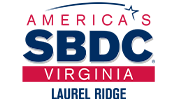Author: Jeff Nicely
2022 State of the Restaurant Industry Report
Published: Published: | ByOn February 1st the National Restaurant Association issued a report that included forecasts for 2022 and the “new normal” eateries face as the nation attempts to move away from COVID. The report provided the following industry insights:
- Industry sales are anticipated to reach $898 billion in 2022
- Foodservice jobs will likely grow by 400,000, for total industry employment of 14.9 million
- 2022 will not be normal for multiple reasons, including food, labor, and occupancy costs, which will be elevated, all of which will impact industry profits
- 96% of operators experienced supply delays or shortages of key food or beverage items, starting in 2021 and likely to continue
- 51% of adult consumers stated that they aren’t eating as often as they would like, an increase of 6% from pre-pandemic levels
- 70% of eateries state that they are not adequately staffed to serve customers
- 50% of operators believe that hiring and retaining staff will be their greatest challenge in 2022
- The industry anticipates adding 200,000 jobs per year for the next decade
- 75% of operators plan to devote more resources to recruiting and retaining employees
- Operators plan to reduce their menu offerings and work to improve the quality of take-out and delivery food products
- 88% of consumers stated that they would be likely try take-out or delivery options if restaurants would use packaging that helps the food maintain the same temperature, taste, and quality as when it’s served in the restaurant
- Technology advances will continue to help the industry, with fully 80% of members stating that their use of technology helps to give them a competitive advantage
- Many operators will expand online ordering, reservations, mobile payment, or delivery management, along with back-of-the-house technology
- Consumers also prefer technology where it doesn’t diminish hospitality
- Outdoor dining is also favored by many consumers, and 40% indicate that they would select eateries with such options over those that do not have it
- To-go alcohol sales are also popular with consumers
- 54% of adult consumers say that takeout or delivery food is essential to their lifestyles, including 72% of millennials and 66% of Gen Z
- 50% of operators think the availability of sidewalk, parking lot, or street seating will become more common during 2022
- 70% of Gen Zs and 62% of millennials stated that to-go alcohol along with take-out or delivery orders would make them more likely to choose one eatery over another without these options
As with many other surveys and data dumps, the results for this critical industry are mixed at best. For those operators that have successfully pivoted during the pandemic and those that continue to do so, 2022 should be OK, but for those that remained viable only due to federal support programs, the coming year will not be a return to “happy days”.
Article thanks to Mike Austin of the VASBDC network.
How to prepare for Virginia’s 31% Minimum Wage Increase
Published: Published: | By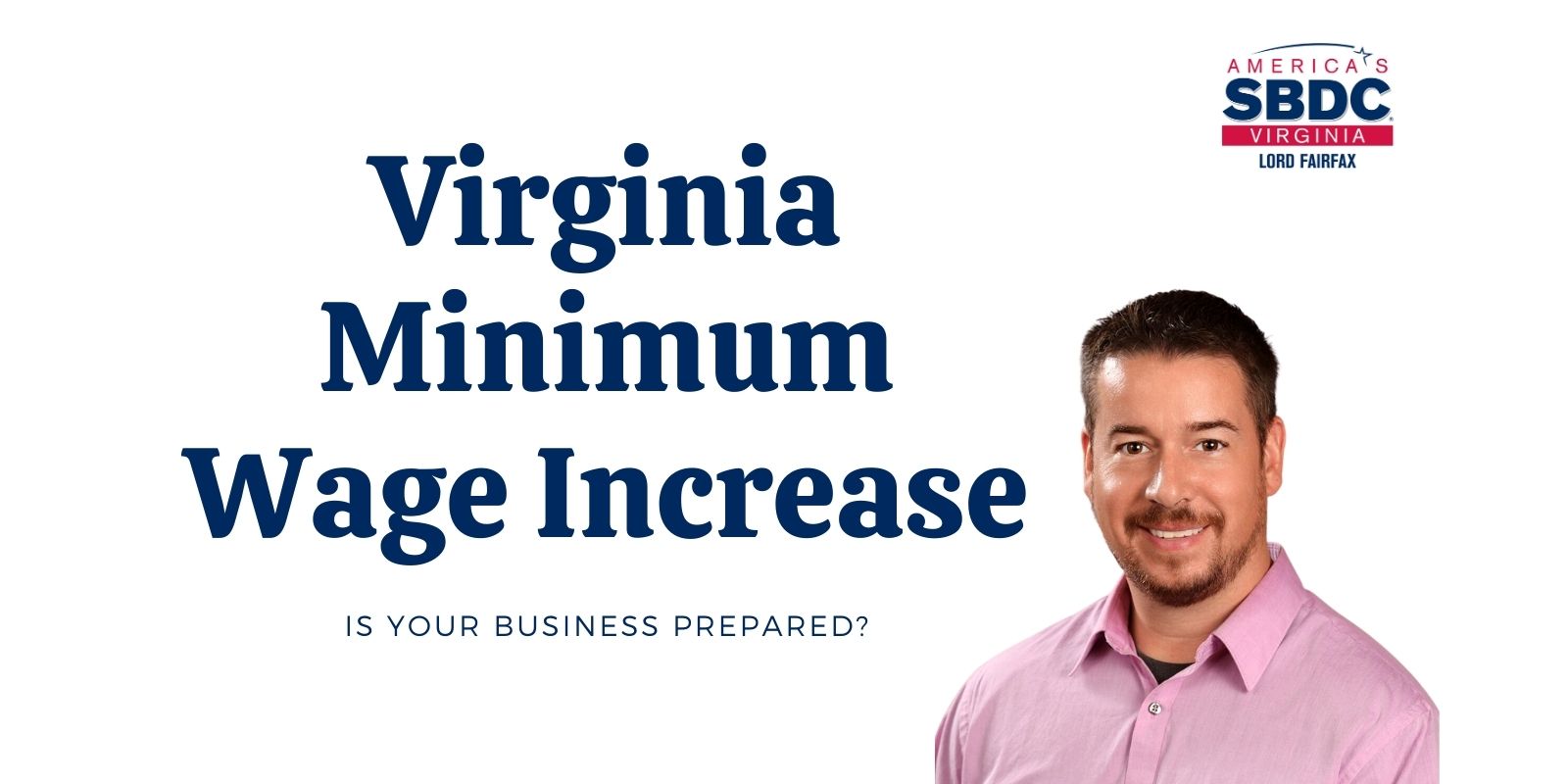
Hello there, I’m Cort Maddox.
I’m an adviser with the Laurel Ridge SBDC and today I get to come to you and talk about changes coming to the Virginia minimum wage.
Not sure if you’ve heard about this but as of May 1, 2021, in the state of Virginia, the minimum wage will go from $7.25 to $9.50.
After that, we will see an increase on January 1, 2022 to $11.00 per hour then every January 1st thereafter until January 1, 2026 if will increase $1.00 per year until it eventually gets to $15.00 per hour.
All of this barring any adjustments from a Federal level, but right now, that’s the plan for Virginia.
Now I want to dive into how this is going impact your business then talk about things you can do to prepare.
First, this is a 31% increase. This is a dramatic increase and one we have not seen in the past. This is going to impact your small business.
I want to go over a potential example to show we as consumers can expect to see and then show how businesses can try to manage this as well.
On January 1, 2022 the minimum wage will increase an addition 16% when it goes from $9.50 to $11.00 per hour. This is a 52% increase which is a big increase given that the average business has an average overhead of about 20-30%.
When you increase your overhead expenses by roughly 52% you can see the impact.
In addition, this will mean an estimated increase of 13% in employer/employee taxes that you will pay on behalf of your employee. This is about a $.50 increase per hour that will need to be taken into account.
Now, let’s consider a $15.00 product.
In order to account for the estimated 59% increase, 52% wage increase plus $.50 per hour in taxes, you will now need to charge $23.85 for that same item to accomplish about the same margin.
That is a heavy hit for customers.
This is why we want to help you to come up with resources to lessen the impact. We want to help you be prepared to make this adjustment without negatively impacting your current customers.
Our team wants to help you keep the number of disgruntled customers as low as possible. We’re all dealing with a lot of things in life right now. Adding another possible stressor to our lives right now is not something we want.
But, this change is coming and you need to be aware of what this change means.
Please make sure you do not violate any labor laws during this process because the consequences will greatly impact your business as well.
We will be hosting an online workshop to provide you more resources. We want to help you navigate these changes because they are going to impact your business.
In the meantime, if you have questions or need help with any business challenge, reach out to our team, we’re here for you at no charge.
Remember, we are funded by the state and local Economic Development Centers, not by small business owners. We are here to serve as your resource. Let us know how we can help!
Struggles Can Bring Out Our Best and Bring Us Together
Published: Published: | By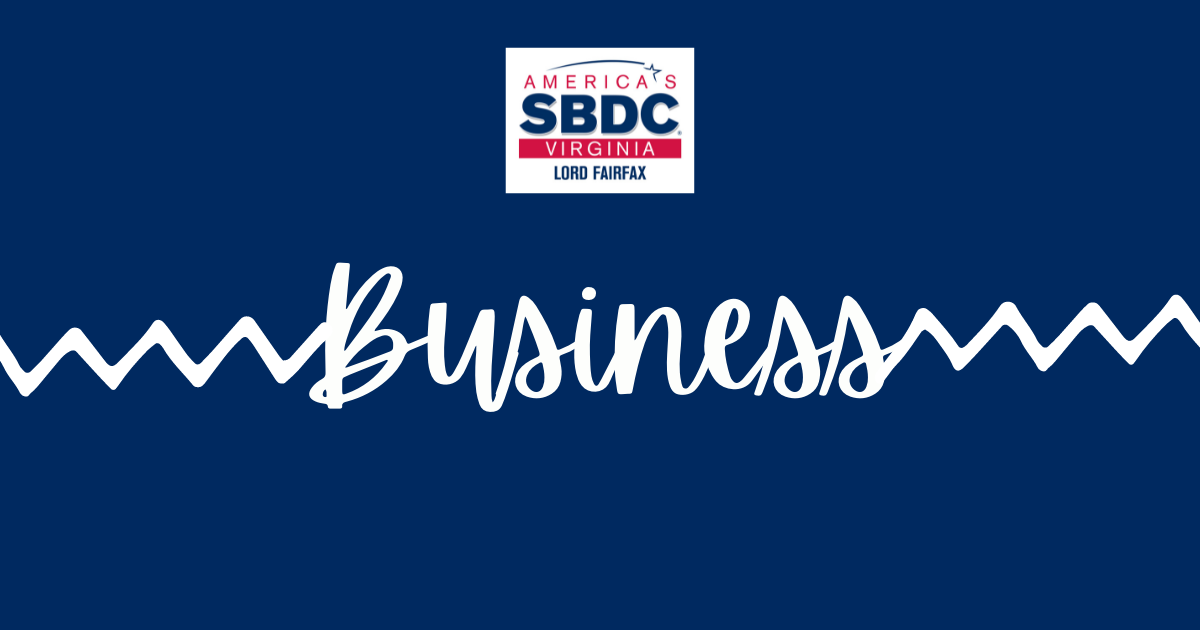
Has life taken it’s toll on you and your business the last few months? Do you feel overwhelmed, stuck and exhausted trying to keep your business going?
You’re not alone. Your struggle is real. Yet our struggles can bring us together.
And yet there’s great news.
As humans, we are made to work with each other. We are wired to look out for each other and to help each other. And when we do, we are more likely to get things done.
By ourselves we cannot lift heavy loads and by ourselves, we cannot solve complex problems. But when we work together, we are remarkable.
If you’re struggling, you do not have to struggle alone. If you have business problems that need to be solved, you do not have to solve them alone.
Our team of experts is ready and available to work with you at no cost. We can work together to solve complex problems and be remarkable with you!One local business owner reached out to our team and had this to say:
“Thank you so much to such a great organization and an amazing community! This feels more like home than anything ever has, for I know my voice and needs are not just heard, but also fulfilled.”
If you haven’t felt pressure in your business, you may.
Some small businesses are going to feel the impact of the Virginia Minimum Wage increase that goes into effect May 1, 2021.
Minimum Wage will increase from $7.25 per hour to $9.50 per hour on May 1, 2021 then on Jan 1, 2022 it will increase to $11.00 per hour. Wages will continue to increase until it reaches $15.00 per hour on Jan 1, 2026.
Let’s make sure you’re prepared with a strategy in place. Our team can help you prepare, at no cost to you. We are funded by state and local Economic Development Centers, not by you the small business owner.
Together, we want to solve complex problems and be remarkable. This is why we exist. We’re here for you!
GO Virginia Grant Brings Lasting Change to Local Small Businesses
Published: Published: | ByThe Small Business Resiliency Training (SBRT) has been working in partnership with the Virginia Initiative for Growth and Opportunity (GO Virginia).
The SBRT Team is made up of members of the Shenandoah Valley and Laurel Ridge Small Business Development Centers.
Thanks to GO Virginia, small business grants were made available and those grants are having a lasting impact on small businesses throughout the Shenandoah Valley of Virginia.
When the Shenandoah Valley Small Business Development Center partnered with Jon Henry General Store in New Market, VA change was quite noticeable. The impact is still being felt.
When Jon Henry came into the SBRT program, he was feeling a bit overwhelmed. Without systems and tools and place to keep his inventory as organized as he’d like, the SBRT program was his solution.
Thanks to the GO Virginia grant, Jon’s small business got a much needed boost.
Listen in as Jon tells about the impact this program had on his small business.
———————————-
The Small Business Resiliency Training (SBRT) was made possible by a grant from the Virginia Initiative for Growth and Opportunity (GO Virginia). This is a business-led initiative formed to foster private sector business growth along with the Small Business Administration and the Virginia Small Business Development Centers. Participating localities include: Augusta County, City of Harrisonburg, City of Waynesboro, City of Winchester, Clarke County, Frederick County, Rockbridge County, Rockingham County and Shenandoah County, VA.
If It’s Free, There Must Be A Catch, Right?
Published: Published: | By
Have you ever said it? Have you heard others say it?
Many people say it all the time. “If it’s FREE, there’s got to be a catch.”
Look, I know a ton of small business owners that say the very same thing.
But does every small business owner who gets free, personalized business coaching fail to grow their business? Of course not.
Just ask Jon Henry, owner of Jon Henry General Store in New Market, VA.
Jon thought that because our services were free there had to be a catch.
After a year of working with our Small Business Development Counselors free of charge, he has implemented new tools and processes into his business that have given him back his time, lowered his stress, and helped him stay more organized which is making him more money.
Jon says that after a year of working with our counselors for free he feels like he should be paying us money, but he isn’t because we are funded by local Economic Development Administrations, not small business owners.
Now you have a choice to make.
You can keep working hard to figure out what to do to grow your small business, or you can do what Jon Henry did.
Reach out to one of our experienced small business counselors who can partner with you to take away the stress of running your business alone.
Give us a call: 540-868-7093
How Jon Henry General Store Made Advancements During the Pandemic
Published: Published: | By
Small Business Resiliency Team (SBRT) Program Helps Jon Henry General Store Implement Changes Needed to Respond to Pandemic
When the Jon Henry General Store opened in New Market in 2018, owner and proprietor Jon Henry could never have guessed that in less than two years he would have to drastically overhaul the way he did business due to a global pandemic. Henry’s vision was to revive the historic Abbie Henkel House (1802) to its past use as a general store and build on his family’s longtime history of Shenandoah Valley farming (and recent pastime of produce peddling along Virginia’s Route 11).
The business quickly made a name for itself by carrying a wide range of products from local makers, growers, and artisans from across the Commonwealth of Virginia, with a primary focus on items from the Shenandoah Valley and a growing number of women and minority-owned companies. Jon Henry’s is also known for actively partnering with local churches, schools and sports teams as sponsor, donor, and participant. This commitment to the local community and the principles of shopping small garnered the company a Future of Shopping Small Grant from Main Street America in partnership with American Express.
But when the pandemic hit in early 2020, Jon Henry needed to quickly make major changes in order to meet customer needs. The store shifted to a touchless point of sale and inventory system to ensure the safety of customers and reduce contamination, and added Supplemental Nutrition Assistance Program (SNAP) and Electronic Benefits Transfer (EBT) services so that more people could access the fresh, nutritious foods the store provides. But the store’s team still faced significant challenges with upgrading outdated software, training employees on new systems, and accomplishing increased accounting tasks.
In late 2020, Jon Henry heard that the Shenandoah Valley and Laurel Ridge Small Business Development Centers had been funded to form a special team that could help. The Small Business Resiliency Team (SBRT) program was created through a grant from GO Virginia and the support of the Cities of Harrisonburg, Waynesboro, and Winchester and Counties of Frederick, Clarke, Rockingham, Shenandoah, Augusta, and Rockbridge. The program deploys Business Resiliency Navigators to guide growth-oriented businesses towards incremental and sustainable growth. SBRT is designed to assist with financial management, eCommerce, and marketing needs for businesses in the tourism, retail, professional services, and healthcare sectors.
Henry applied for help with upgrading the business to QuickBooks Online and extending the services of his bookkeeper to complete the system migration and fully train employees for best practices on the new systems. Henry talked about how the process played out once he had been approved for the SBRT program:
“Helen spent good time with me on demos and wrote up new closing process for staff etc. with our new systems. It was a bit of a hog on time to convert and [reconcile] with Clover [his POS system]. [It has been] very helpful to finally have the inventory all aligned with our new POS and QuickBooks.”
After a few weeks with the new systems, he said: “I am loving it [QuickBooks online] already. The cellphone app allows me to snap invoice pics, which is great with our on-farm pick-ups.”
Henry went on to say that the SBRT program provided the time and expertise needed to work the kinks out of the new procedures, review the added services for cost effectiveness, and gauge how well they were being adopted in the community. He hopes to use this information to tweak the systems going forward.
Jon Henry’s work with the SBRT Navigators also led to being connected with James Madison University’s BizLab, a digital services group matching JMU students with small businesses and non-profits to help companies strengthen their online presence. Students work with customers to create websites, design logos and other graphics both for online and print. “I am loving the website, and it’s amazing the commerce that we’ve already run through it!” Henry said about the collaboration.
“The process of applying for the SBRT program is really simple, and the SBDC can usually engage locally-available providers for the services our clients need. We hope that more businesses in the counties of Augusta, Clarke, Frederick, Rockbridge, Rockingham, and Shenandoah; and the cities of Harrisonburg, Waynesboro, and Winchester will apply to take advantage of this program,” said Joyce Krech, Director of the Shenandoah Valley Small Business Development Center.
If the walls of the Abbie Henkel House could talk, they would probably agree. Making good use of your local community resources, especially during times of crisis, are an important part of resiliency and longevity. What could SBRT do for your business during these tough times?
For more information on the Small Business Resiliency Teams, visit the SBDC websites: www.ValleySBDC.org or www.laurelridgesbdc.org, or contact Joyce Krech, (540)568-3227, [email protected] or Christine Kriz, (540)868-7094, [email protected].
For more information on GO Virginia, visit the Shenandoah Valley Partnership (https://theshenandoahvalley.com/) or Virginia Department of Housing and Community Development (https://www.dhcd.virginia.gov/gova).
About Small Business Development Centers. The SV and LF SBDCs are two of 29 Small Business Development Centers across Virginia providing professional business advice, training, and information resources to help grow and strengthen local businesses and Virginia’s economy. They are hosted respectively by James Madison University and Laurel Ridge Community College in partnership with George Mason University and funded in part by SBA and local governments. The Virginia SBDC Network (www.VirginiaSBDC.org) is the most extensive business development program in the Commonwealth and part of America’s SBDC – the nation’s proven, cost-effective, and accredited infrastructure focused on small businesses – America’s job creators.
March National Days to Boost Your Social Media
Published: Published: | ByYour inbox is full and your to-do list is growing. Where will you find time to make those all important social media posts?
Try March National Days. They have proven to increase engagement and can start those much needed client conversations.
We want to save you time so we’ve put these lists together in this blog post.
Since engagement is the name of the social media game, we’ve tested National Days, Hashtags, Public Holidays and Monthly Observances. And they have proven to boost our engagement.
In addition to National Days, make sure you’re posts include high quality graphics that visually communicate the message of your post. When you nail the message with your graphics, you win!
If you need help creating show-stopping graphics, check out Canva.
When you face social media or business challenges, contact us. We have a tea of specialists who can help you.
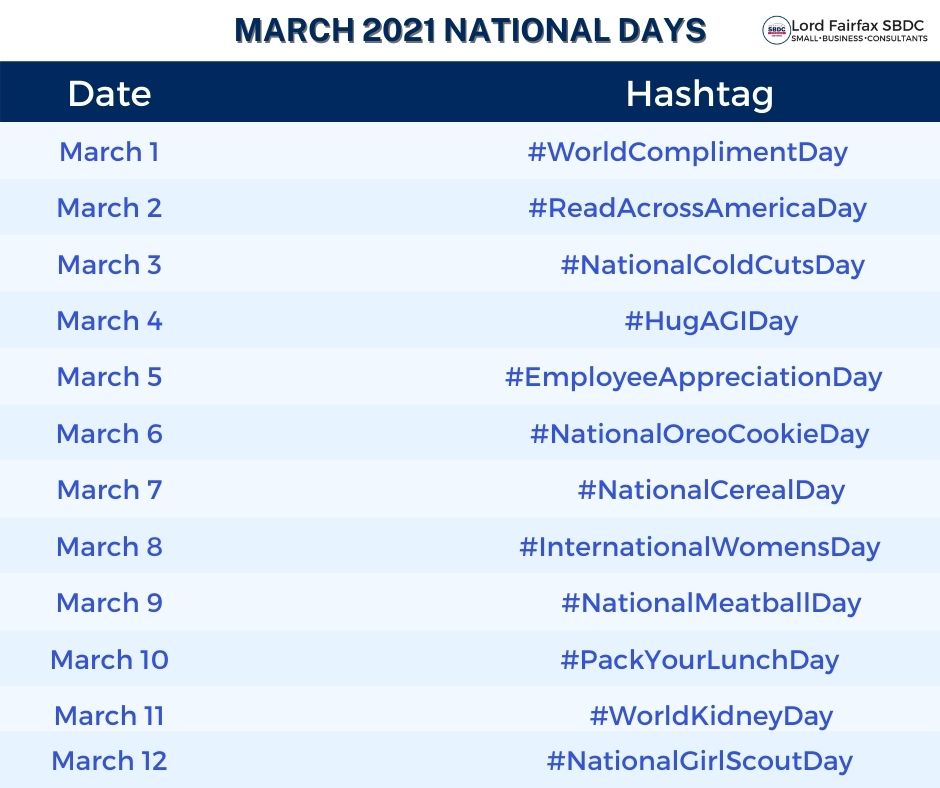
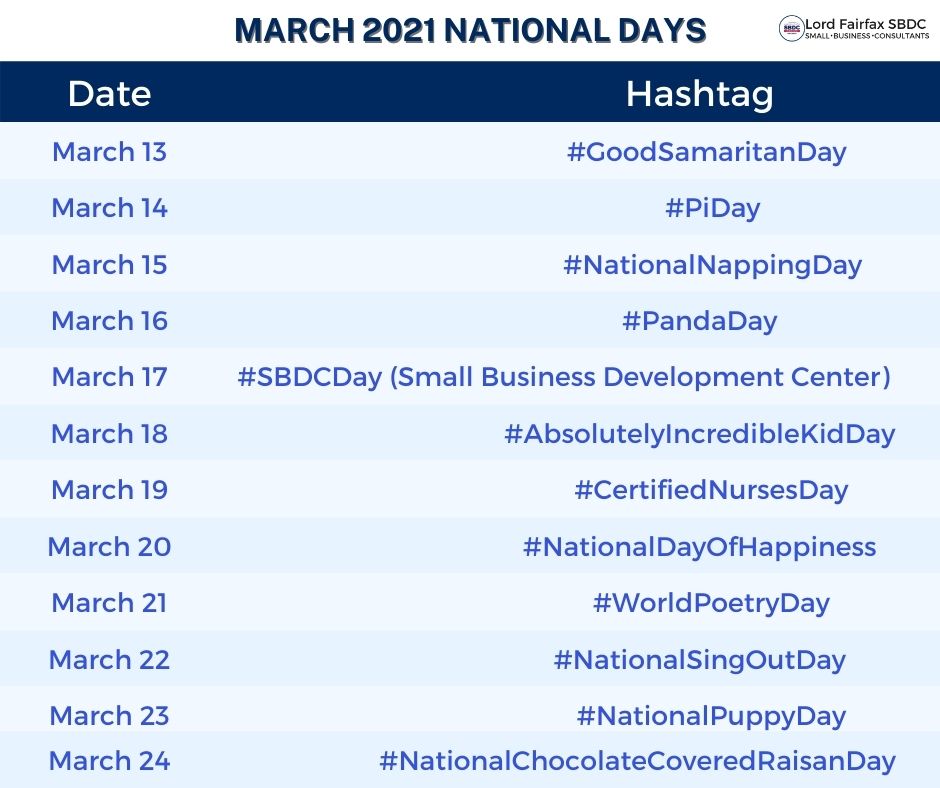
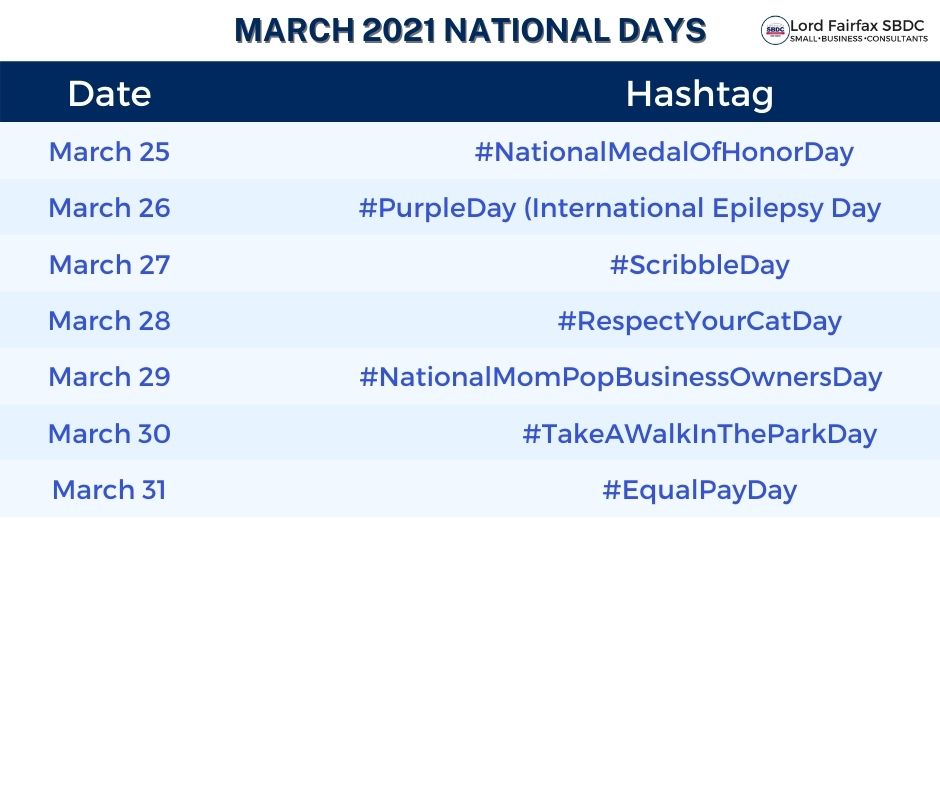
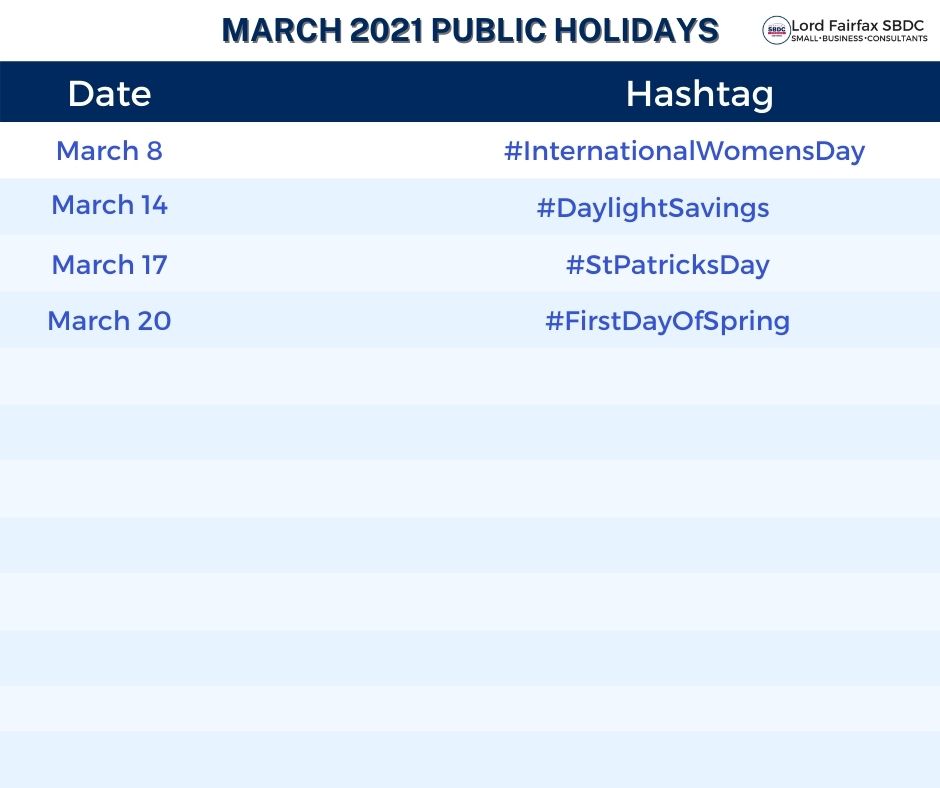
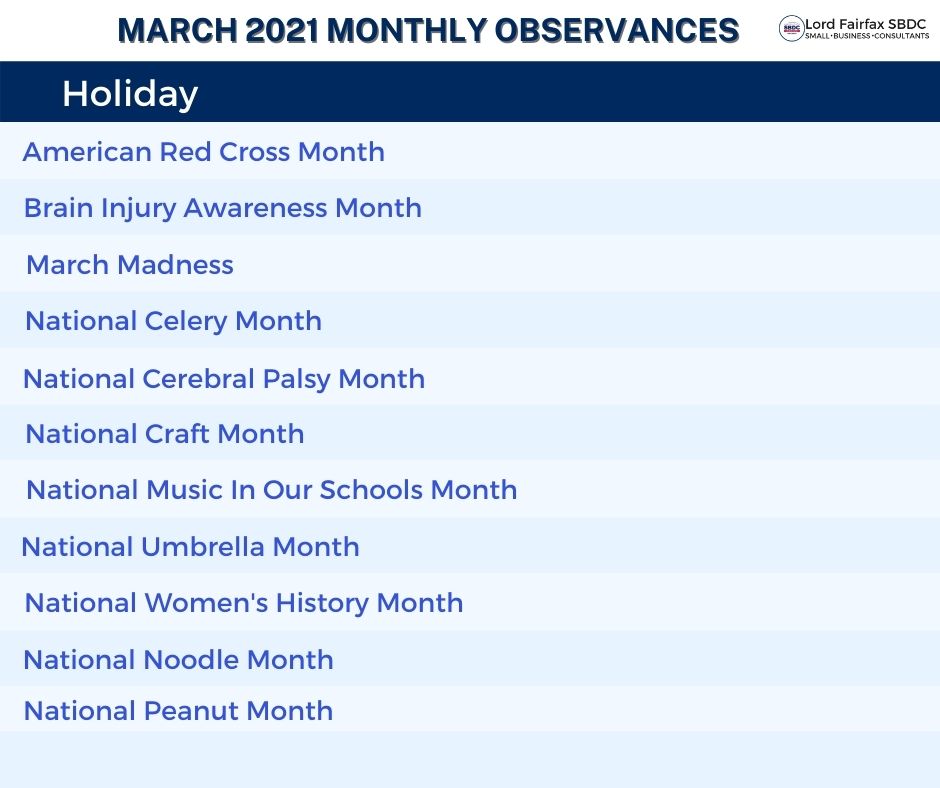
When you need the help of our team, we are here. Reach out to us. Our services are FREE today and always. You have nothing to loose.
**This post may contain affiliate links that pay referral fees.
Give Your Social Media Engagement A Boost
Published: Published: | ByDo you make social media posts for your business? Ever get stuck and wonder what to post next? Think it’s time to give your social media engagement a boost?
Try National Days. They have proven to increase engagement and shares.
And to make it super easy for you, we’ve put together a list of February National Days. And we have a lot more ideas.
SEND ME MORE SOCIAL MEDIA POST IDEAS



If you or someone you know has a business challenge that our team can help with, please reach out to us here.
Our services are always FREE. We’re here to help and our team is ready to go!
Effective Local eCommerce Strategy for Small Business
Published: Published: | ByHow do you eat an elephant? As the adage goes, bite by bite. This works when you think a problem is too big to manage all at once, but it also makes a great deal of sense when it comes to local eCommerce strategy.
Consider the probability of any eCommerce startup skyrocketing to “unicorn” status. These usually require millions of dollars in angel and venture capital, and even then the vast majority of eCommerce shops fail early (90% in the first few months) and even after a year in business (it stands at around 78%) . Do you know what one component most of these eCommerce sites are missing?
Focus.
And, more specifically, localization. Localization is important to eCommerce, because people like to do business with businesses that are near them for a variety of reasons. These include familiarity, convenience, better customer service, loyalty, and trust. Further, there is a strong Shop Local movement happening, which has made consumers more conscious and conscientious about shopping local even when they’re shopping on the Web.
eCommerce Website Sales Strategy
While having a website is fundamental to business visibility today, it’s important that business owners recognize the value of a website’s connection to sales.
Websites are where sales happen online today. So, why would a business website not have some ability to display products or services, and take payments? (If the COVID-19 pandemic has taught us nothing else, it’s that it’s vital to be able to reach customers and continue to transact business online in the face of dynamic circumstances.)
So, we start with a sales strategy and then we build an eCommerce website to support its purposes. What are you selling? And, how does the website fit the needs to sell it/them?
Moreover, much of the past two decades’ worth of marketing research demonstrates that the supermajority of your sales will come from consumers within a five-mile radius. Google noticed this with consumers performing local searches and purchasing via mobile ads, and it biases search results in Google’s Local Search to around that same distance.
Businesses that have a great eCommerce presence can capture the 70+% of local searchers who go to a business’s website standing outside the store. If a potential customer finds what they need on your website, even if they don’t buy on the eCommerce website, they are likely to enter the physical store and purchase from you. This cannot be underscored enough times.
Online shopping promotes physical retail, and supports physical retail when it’s not possible or as a convenience to the customer. Local eCommerce is the best thing to happen to local commerce. All it takes is understanding this premise when building your website strategy. And, so, what should your website strategy look like?
Email Is Important
At the heart of every eCommerce website marketing strategy is email. It’s the stitching that holds together the fabric of online sales. From email marketing newsletters to email sales funnels and emailed receipts with requests for reviews.
Some questions to consider in building your local eCommerce email marketing:
- How will you generate leads to capture their emails?
- Where does email marketing (i.e., promotional, relational and transactional messages) fit into your overall business strategy?
Which email marketing service provider has all the features you need at the price you can afford?
To learn more, check out this article on small business email marketing strategy.
Mobile Is Dominant
If it wasn’t already apparent, people are using mobile phones more than ever and it’s driving sales. Whether it’s for researching online to buy offline (ROBO buyers) or for safety, convenience, or loyalty to a brand, mobile arguably has a hand in almost every sale happening online today.
- Some questions to consider in building your mobile marketing:
- Is your website mobile-optimized?
- Is your content “snackable” and organized for mobile reading?
- Back to email, how are you capturing leads through email capture on mobile?
- How are you connecting a mobile visitor to your products/services?
Learn more here about small business mobile marketing strategies.
Content Marketing & Advertising
While much ado has been made of social networks like Facebook, Instagram, Twitter, LinkedIn and Snapchat for its ability to get in front of potential customers. And, yes, they can get your business in front of many people. You need to create content on your local eCommerce site that is worth creating Social Media posts about, that drives visitors. And, while social networks like
your Social Media posts, you need to have a budget for advertising your best performing content to people beyond those who merely follow you.
If you want to excel in local eCommerce you need a mix of great content (in the form of blog posts, podcast episodes, or videos), Social Media posts that bring people to your site (organically and through social ads), and products and services on your website that can convert visitors.
Here are a few important questions to think about related to content marketing:
- What localized content do you need to produce to bring potential buyers to your local eCommerce website?
- How does your content marketing connect a potential buyer’s felt need or want to what you offer?
- Do you have a content calendar so that you can keep on top of creating enough of the right content?
- How will you measure the success of your content marketing efforts for your
eCommerce website?
Here is a great article on digging in deeper into small business content marketing.
Local Search Optimization: Local Schema, Hyper-
targeted Local Content, and Local Listing Directories
The last ingredient in local eCommerce strategies is far from the least important–local search optimization. Three different parts combined on and off the eCommerce website itself make up local search optimization: local schema, local content (hyper-targeted, preferably), and local listings.
Local Schema
Google (and the other search engines) use structured content (just like HTML), Schema markup, on local websites (including eCommerce sites) to display rich snippets to local searchers. Schema allows not only the business to get visibility on Google, but it also provides an ability to get specific content and products on your eCommerce site to be shown to more people by using it.
At the very least, your eCommerce site should display your name, local business address, local phone number, and hours of operation using the Schema markup. If your eCommerce website doesn’t have the functionality built into it, you can use Google’s Structured Data Markup Helper and Structured Data Testing Tool to add and test how your Schema looks on your site.
Also, if you have a product catalog in your eCommerce site, you will want to push the product feed into Google Shopping.
Hyper-Targeted Local Content
Next, you can create a volume of local content that is great for Google without much more work than generating the original content in the first place. This method requires you to create your base pages for your products and services. Then, you can identify all the localities and landmarks for which you’d like your product or service to appropriately rank on Google.
The tricky part is understanding how web pages are displayed to Google and website visitors versus those displayed in the menu navigation of the eCommerce site. For hyper-targeted local pages, you only care about Google seeing those pages and directing visitors to them, but they will not be displayed in your website’s navigation menu.
For example, you might have a “Men’s Haircuts” page on your local business website and people can book appointments and pay/tip online. But, if you have a hyper-targeted local page for every neighborhood that your hair salon business serves, you’ll rank better and gain more traffic. So, you might have pages that are duplicates of the main page but are modified (approximately 20% different than the original), such as “Men’s Haircuts on Main Street”, “Men’s Haircuts in Somewheresville” and “Men’s Haircuts in the Neighborhoodsname”. These pages will include content that highlights the locality and landmarks, and because they’re 20% different than the main page, Google will see them as different than the main page and they’ll rank well for when people type those local searches into Google.
Local Directory Listings
Finally, but just as powerful, it is important for local commerce and local eCommerce alike to take advantage of local directories. These are online business directories that can generate a good amount of traffic for savvy small business owners.
The most prominent today is Google My Business, but there are many others available (see the sites that Local Listing Ninja submits to as a service to get an idea about how many there are).
The important part is to keep the listings data (especially hours of operation and website details)
up-to-date, and with Google My Business, it provides a portal to post updates, offers, products
and services, and even eCommerce links (purchase, appointment/booking, online courses,
events, etc.).
Conclusion
eCommerce sites are tough to launch, so don’t you want to do it well enough so that it actually pays for itself and more? Use this eCommerce marketing framework to consider how your products/services are going to be positioned on the Local Web. Then, consider how your mobile-optimized website is going to handle your sales, what your email marketing is going to
do for you, what content marketing you’ll create and when/where you’ll distribute it, and then how you’ll optimize for Local Search.
When you do these things well, you have a local eCommerce website that has a chance of standing up to Big Box eCommerce and outpacing your competition.
Thanks to Ray Sidney-Smith, guest author of this post.
